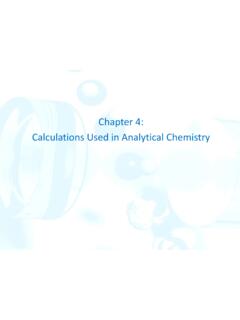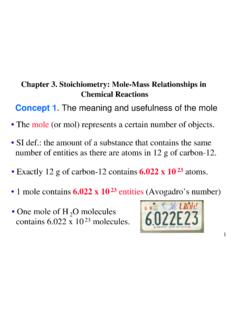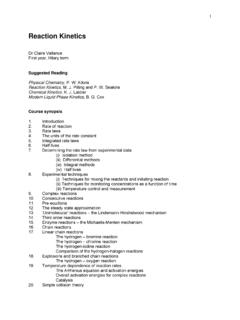Transcription of Chemistry for High School
1 1 Chemistry for High School2 Chemistry for High SchoolFirst Edition, 2019 Copyright @ Elemental Science, : EditionPrinted in the USA for worldwide distributionFor more copies write to:Elemental SciencePO Box 79 Niceville, FL PolicyAll contents copyright 2019 by Elemental Science. All rights part of this document or the related files may be reproduced or transmitted in any form, by any means (electronic, photocopying, recording, or otherwise) without the prior written permission of the author. The author does give permission to the original purchaser to photocopy the quizzes and appendix materials for use within their immediate family of Liability and Disclaimer of Warranty: The publisher has used its best efforts in preparing this book, and the information provided herein is provided as is. Elemental Science makes no representation or warranties with respect to the accuracy or completeness of the contents of this book and specifically disclaims any implied warranties of merchantability or fitness for any particular purpose and shall in no event be liable for any loss of profit or any other commercial damage, including but not limited to special, incidental, consequential, or other : This book identifies product names and services known to be trademarks, registered trademarks, or service marks of their respective holders.
2 They are used throughout this book in an editorial fashion only. In addition, terms suspected of being trademarks, registered trademarks, or service marks have been appropriately capitalized, although Elemental Science cannot attest to the accuracy of this information. Use of a term in this book should not be regarded as affecting the validity of any trademark, registered trademark, or service mark. Elemental Science is not associated with any product or vendor mentioned in this for High School - Table of ContentsChemistry for High School Table of ContentsIntroductionIntroduction to this Guide 7An Explanation of the Sections 7 What a full Lab Report should include 10 More Information on Lab Reports 12 Adding Current Events into your Science Studies 13 The Scientist Biography Report 14 The In-depth Project 16 The Research Report 17 unit 1: Introduction to ChemistryWeek 1 notes - Introduction to Chemistry 20 Week 1 Supply List 22 Week 1 Course Schedules 23 Week 2 notes - Matter and Change 26 Week 2 Supply List 28 Week 2 Course Schedules 29 Week 3 notes - Measurements 32 Week 3 Supply List 34 Week 3 Course Schedules 35 Week 4 notes - Atomic Structure, part 1 38 Week 4 Supply List 40 Week 4 Course Schedules 41 Week 5 notes - Atomic Structure, part 2 44 Week 5 Supply List 46 Week 5 Course Schedules 47 Week 6 notes - Electrons, part 1 50 Week 6 Supply List 52 Week 6 Course Schedules 53 Week 7 notes - Electrons, part 2 56 Week 7 Supply List 58 Week 7 Course Schedules 59 Chemistry for High School - Table of Contents4 Week 8 notes - The Periodic Table 62 Week 8 Supply List 64 Week 8 Course Schedules 65 Week 9 notes - Nomenclature 68 Week 9 Supply List 70 Week 9 Course Schedules 71 unit 2.
3 Bonding and ReactionsWeek 1 notes - Ionic and Metallic Bonding 76 Week 1 Supply List 78 Week 1 Course Schedules 79 Week 2 notes - Covalent Bonding 82 Week 2 Supply List 84 Week 2 Course Schedules 85 Week 3 notes - The Mole 88 Week 3 Supply List 90 Week 3 Course Schedules 91 Week 4 notes - Chemical Reactions 94 Week 4 Supply List 96 Week 4 Course Schedules 97 Week 5 notes - stoichiometry 100 Week 5 Supply List 102 Week 5 Course Schedules 103 Week 6 notes - States of Matter, Part 1 106 Week 6 Supply List 108 Week 6 Course Schedules 109 Week 7 notes - States of Matter, part 2 112 Week 7 Supply List 114 Week 7 Course Schedules 115 Week 8 notes - Behavior of Gases, part 1 118 Week 8 Supply List 120 Week 8 Course Schedules 121 Week 9 notes - Behavior of Gases, part 2 124 Week 9 Supply List 126 Week 9 Course Schedules 1275 Chemistry for High School - Table of ContentsUnit 3: Water and EquilibriumWeek 1 notes - Water 132 Week 1 Supply List 134 Week 1 Course Schedules 135 Week 2 notes - Solutions, part 1 138 Week 2 Supply List 140 Week 2 Course Schedules 141 Week 3 notes - Solutions, part 2 144 Week 3 Supply List 146 Week 3 Course Schedules 147 Week 4 notes - Thermochemistry, part 1 150 Week 4 Supply List 152 Week 4 Course Schedules 153 Week 5 notes - Thermochemistry, part 2 156 Week 5 Supply List 158 Week 5 Course Schedules 159 Week 6 notes - Kinetics 162 Week 6 Supply List 164 Week 6 Course Schedules 165 Week 7 notes - Equilibrium 168 Week 7 Supply List 170 Week 7 Course Schedules 171 Week 8 notes - Entropy and Free Energy 174 Week 8 Supply List 176 Week 8 Course Schedules 177 unit 4.
4 Organic Chemistry and MoreWeek 1 notes - Acids and Bases, Part 1 182 Week 1 Supply List 184 Week 1 Course Schedules 185 Week 2 notes - Acids and Bases, Part 2 188 Week 2 Supply List 190 Week 2 Course Schedules 191 Chemistry for High School - Table of Contents6 Week 3 notes - Oxidation-Reduction Reactions 194 Week 3 Supply List 196 Week 3 Course Schedules 197 Week 4 notes - Electrochemistry 200 Week 4 Supply List 202 Week 4 Course Schedules 203 Week 5 notes - Nuclear Chemistry 206 Week 5 Supply List 208 Week 5 Course Schedules 209 Week 6 notes - Organic Chemistry , part 1 212 Week 6 Supply List 214 Week 6 Course Schedules 215 Week 7 notes - Organic Chemistry , part 2 218 Week 7 Supply List 220 Week 7 Course Schedules 221 Week 8 notes - Biochemistry, part 1 224 Week 8 Supply List 226 Week 8 Course Schedules 227 Week 9 notes - Biochemistry, part 2 230 Week 9 Supply List 232 Week 9 Course Schedules 233 AppendixAdditional Supplies from Home Master Supply List 239 Hands-on Activities Master Supply List 241 Scientist Biography Report Grading Rubric 243 Science in the News 2457 Chemistry for High School - IntroductionIntroduction to this GuideWelcome to Chemistry !
5 This year, you will learn about matter, atomic structure, reactions, and much more. In this guide, you will find three types of schedules, as well as notes with the assignments for each week. To get links to the textbook, teacher guide, experiment, and quick-links for the activities in this guide, please visit: Courses in OneThis guide contains the plans for three courses in one book. These are: )Honors - The plans in this option are for a lab science, 1-credit Honors Chemistry course. There are textbook assignments, experiments, events in science, optional hands-on activities, and written work with these plans. Expect to take about 5 to 6 hours a week to complete these plans. We recommend this option for students who plan on going into the sciences. The honors course will also fulfill a lab science credit for graduation. )Standard - The plans in this option are for a standard lab science, 1-credit High School Chemistry course.
6 There are textbook assignments, experiments or online labs, and written work with these plans. Expect to take about 4 to 5 hours a week to complete these plans. We recommend this option for students who are not and for students who are planning on going into the sciences. The standard course will fulfill a lab science credit for graduation. )Survey - The plans in this option are for an information-only, 1-credit Survey of Chemistry course. There are textbook assignments, written work, and events in science with these plans. There are no experiments or hands-on activities scheduled with these plans. Expect to take about 4 to 5 hours a week to complete these plans. We recommend this option for students who are not planning on going into the sciences and do not need a lab science credit for graduation. Each of the scheduling pages will note at the top which course the plans are for. These schedules for these courses are suggestions; please check wil your local oversight contact to make sure that you are meeting your state s graduation requirements.
7 Please feel free to tailor this program to the needs of your students. An Explanation of the SectionsAfter the scheduling pages, you will find the notes sheets. These sheets are divided into four sections - textbook, experiments, events in science, and hands-on activities. Here is an explanation of each of these this study, we have chosen to use the standard text book, CK-12 Chemistry Intermediate. Chemistry for High School - Introduction8 You can download this text as a pdf from the resource page above. You will complete the reading assignment and then answer several of the questions from the text. These answers should be added to the reading section of the science notebooks. You will also define several of the key terms from the chapter. The definitions should be added to the glossary section of the science the experiments come from the Standard Home School Chemistry Laboratory Kit Instruction Manual, along with the corresponding experiment kit.
8 You can download the guide for free and purchase the kit (CK01B Standard Home School Chemistry Laboratory Kit) from here: each of these experiments, you will find a purpose, required pre-reading, procedure, lab notebook assignments, and lab questions. For each week, we have included a supply list for your convenience. If you would like to see a full list of the household supplies you will need in addition to the experiment kit, please see pg. 239 in the Appendix. We have also incorporated an optional online lab into the standard course. These online labs are available through Beyond Labz. You can visit the resource page for this program for directions on how to sign up and use these labs or visit their website directly at: part of unit 1, the standard- and honors-course students will complete a full lab report for one of the experiments. We have included an explanation of what a full lab report includes after this introduction.
9 Events in ScienceThis section gives two options for the Events in Science section. One will familiarize you with current events in science, as you research on the internet for the various topics. The other will familiarize you with the key historical figures in Chemistry through the scientist biography report. We have included two articles to explain these options in more depth following this ActivitiesWe have also included optional hands-on experiments for each week. You can see a list of the supplies you will need for these in the Appendix on pg. 241. The Science NotebookThis year, you will each create a science notebook. Each notebook should contain the following sections:9 Chemistry for High School - Introduction Reading (All Students) - This section of the notebook will contain any notes you have taken, along with the answers to the questions that were assigned each week. Lab (Standard- and Honors-Course Students Only) - This section of the notebook will house the notes from the experiments you have done, along with any other materials relating to the labs.
10 Events (Survey- and Honors-Course Students Only) - This section of the notebook will include either the current events article summaries or the historical reports you have done. Glossary (All Students) - This section of the notebook will have the definitions for the assigned vocabulary notebook can be a composition book, divided into the required sections, or a three-ring binder with dividers for each and CreditsThe three options in this guide meet the requirements for a full credit of high School Chemistry , as explained above. Each week, the student will answer lab and textbook questions, do events in science written work, and define vocabulary that can count toward a classwork grade for the course. The textbook for this course has chapter tests available for free in the quizzes and tests packet. We suggest that you use these for the exam grade for the course. We suggest you use the following percentages to come up with a final grade for the course: )Class work: 70% )Exam: 30%Note - A grading rubric for the Scientist Biography Reports can be found on pg.











